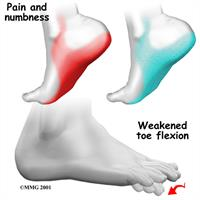Tarsal Tunnel Syndrome
What is Tarsal Tunnel Syndrome?
The Tarsal Tunnel is the canal formed between the bone on your inner ankle (medial malleolus) and a structure that runs across the inside of the ankle and foot to hold tendons down (flexor retinaculum). Tarsal tunnel syndrome is a painful foot condition in which the posterior tibial nerve is compressed or squeezed causing symptoms anywhere along the path of the nerve. Very simply, this commonly presents as diffuse inner ankle pain.
ankle (medial malleolus) and a structure that runs across the inside of the ankle and foot to hold tendons down (flexor retinaculum). Tarsal tunnel syndrome is a painful foot condition in which the posterior tibial nerve is compressed or squeezed causing symptoms anywhere along the path of the nerve. Very simply, this commonly presents as diffuse inner ankle pain.
Who is at risk of developing it?
Tarsal Tunnel Syndrome has many possible causes most of which are idiopathic (meaning spontaneously) and mostly occurs when the nerve is severely compressed. Issues of compression can include:
- Flat feet (over-pronation): When your foot rolls in when you walk or run, this can produce tension and compression on the nerve. This commonly builds over time after an extended period of pressure is placed on the inner ankle.
- Enlarged or abnormal structures that occupy the space within the tarsal canal can compress the nerve, such as a ganglion cyst or mass.
- Trauma/injury: This can cause inflammation and swelling resulting in compression of the nerve.
Symptoms of Tarsal Tunnel Syndrome include:
- Pain and tingling in and around the inner ankle and sometimes the toes.

- Swelling of the feet.
- Pain radiating up into the leg or alternatively into the arch, heel, and toes.
- Hot and cold sensations in the feet.
- Burning sensation on the bottom of the foot.
- Difficulty with any high impact activity.
- Pins and needles and increased sensation on the feet.
- Can be diagnosed by symptom history and gently tapping on the inner ankle over the nerve path to reproduce pain and tingling (this is called Tinel’s sign).
What are treatments used to manage Tunnel Tarsal Syndrome?
Early treatment of the symptoms is very important. Left untreated, tarsal tunnel syndrome can progress and may result in permanent nerve damage. Furthermore, because the symptoms of tarsal tunnel syndrome are similar to other conditions, such as referred pain from the lumber region of the back, an assessment by a podiatrist is essential so that a correct diagnosis can be made and an appropriate treatment plan can be started. Some aspects of the treatment plan may include:
- Stage 1 treatment protocols:
- Relative rest and modified activity – Try avoiding activities that cause or aggravate symptoms to prevent further injury and promote healing.
- Ice – To ease pain and swelling.
- Anti-inflammatory – Nonsteroidal anti-inflammatory drugs (NSAIDs) can help reduce pain and swelling in the tarsal tunnel.
- Gentle neural mobilisation exercises prescribed by your podiatrist in conjunction with some unloading techniques such as wedging and taping.
- Possible footwear change to a more suitable shoe.
- Stage 2 and 3 treatment protocols:
- Physical therapy – more detailed exercises, stretching, dry needling and other physical therapy modalities may be prescribed to reduce symptoms.
- Injection therapy – injections of a local anaesthetic can provide pain relief and in some instances an injected corticosteroid may be useful in treating the inflammation and pain.
- Orthotic therapy – a custom orthotic device placed in your shoe can help address possible causative factors such as flat feet in order to reduce compression of the nerve.
- Adequate footwear – Supportive footwear may also be recommended.
- Immobilisation – restricting movement of the foot by wearing a boot is sometimes necessary to enable the nerve and surrounding tissue to heal.
- Stage 4 treatment protocol:
- Surgery – Surgical decompression of the area to release chronic stress and pain.
If you think you may be experiencing these symptoms then contact us today to get immediate pain relief!
